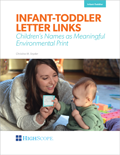ABOUT LETTER LINKS
What are letter links?
The Letter Links name learning system pairs a child’s printed nametag with a letter-linked
picture for a word that starts with the same letter and sound. For example, Debbie’s
letter link includes her nametag plus a picture of a duck or a deer, and Teodoro’s
might include his nametag plus a picture of a tepee or a turtle.
The Letter Links system enables you to introduce your students to letter names and
sounds by building on children’s natural attachment to their own names. As children
use letter links to identify themselves and their classmates, they begin to develop
an understanding of the alphabetic principle — the understanding that alphabet letters
and the sounds of speech are connected. Children also build phonological awareness
— the ability to attend to the sounds of language as distinct from its meaning.

 Letter links can be used by children and teachers in many ways: to label children’s
artwork and belongings in the classroom; to identify children in classroom signs,
lists, and messages; and to create fun and engaging classroom literacy activities.
Letter links can be used by children and teachers in many ways: to label children’s
artwork and belongings in the classroom; to identify children in classroom signs,
lists, and messages; and to create fun and engaging classroom literacy activities.
Letter Links Online provides images for both English and Spanish words, so teachers
with Spanish-speaking children in their classrooms have a wide range of choices.
For example, if Teodoro is an English language learner who speaks Spanish at home,
the teacher might choose a letter-linked picture for a Spanish word such as toro
(bull) or tambor (drum).
For more information and ideas for using the Letter Links name learning system in
the classroom, as well as background information on the research and literacy learning
principles behind the letter links system, please consult Letter Links: Alphabet
Learning With Children’s Names, by Dr. Andrea DeBruin-Parecki and Mary Hohmann,
or the Spanish version, Enlaces de letras: Aprendizaje del alfabeto con los nombres
de los niños. For more on how Letter Links supports infants’ and toddlers’
communication, language, and literacy growth, please see Infant-Toddler Letter Links:
Children’s Names as Meaningful Environmental Print by Christine Snyder. For more information
on the content of these books and how to order them, click on
Resources in the menu bar above.